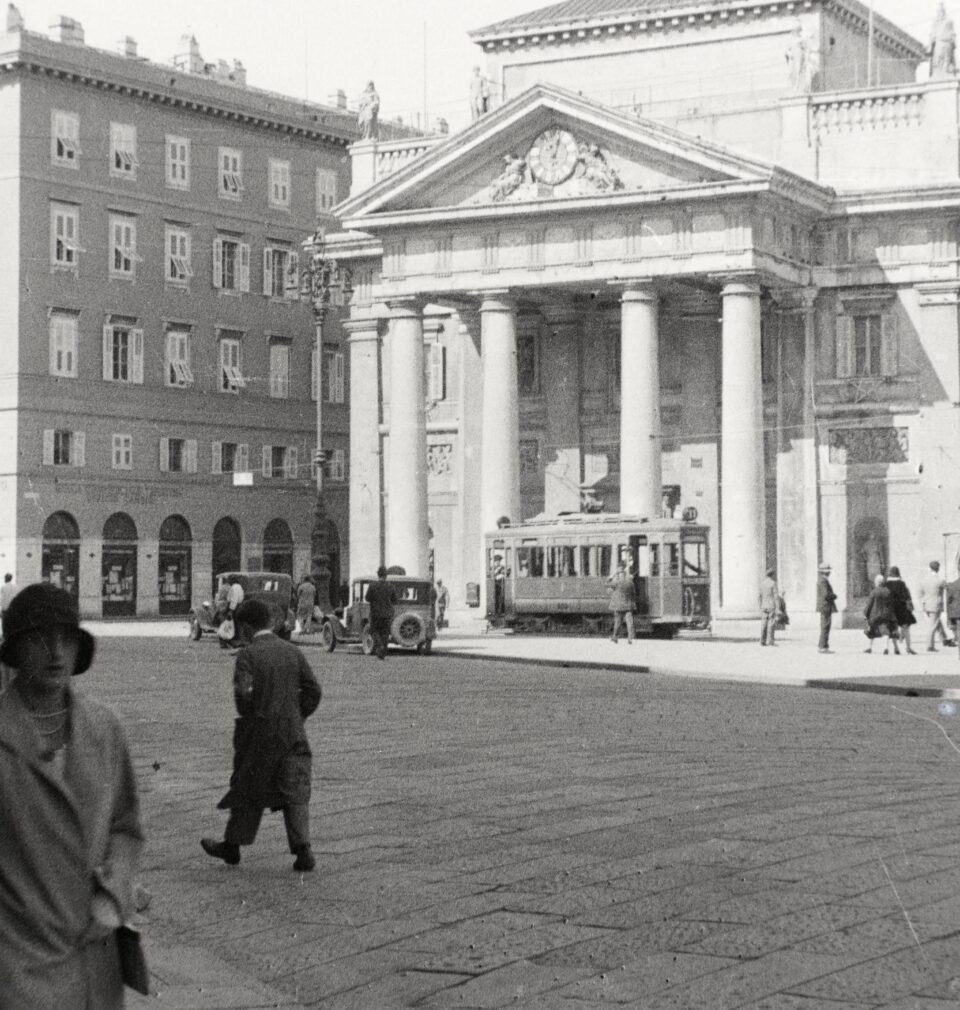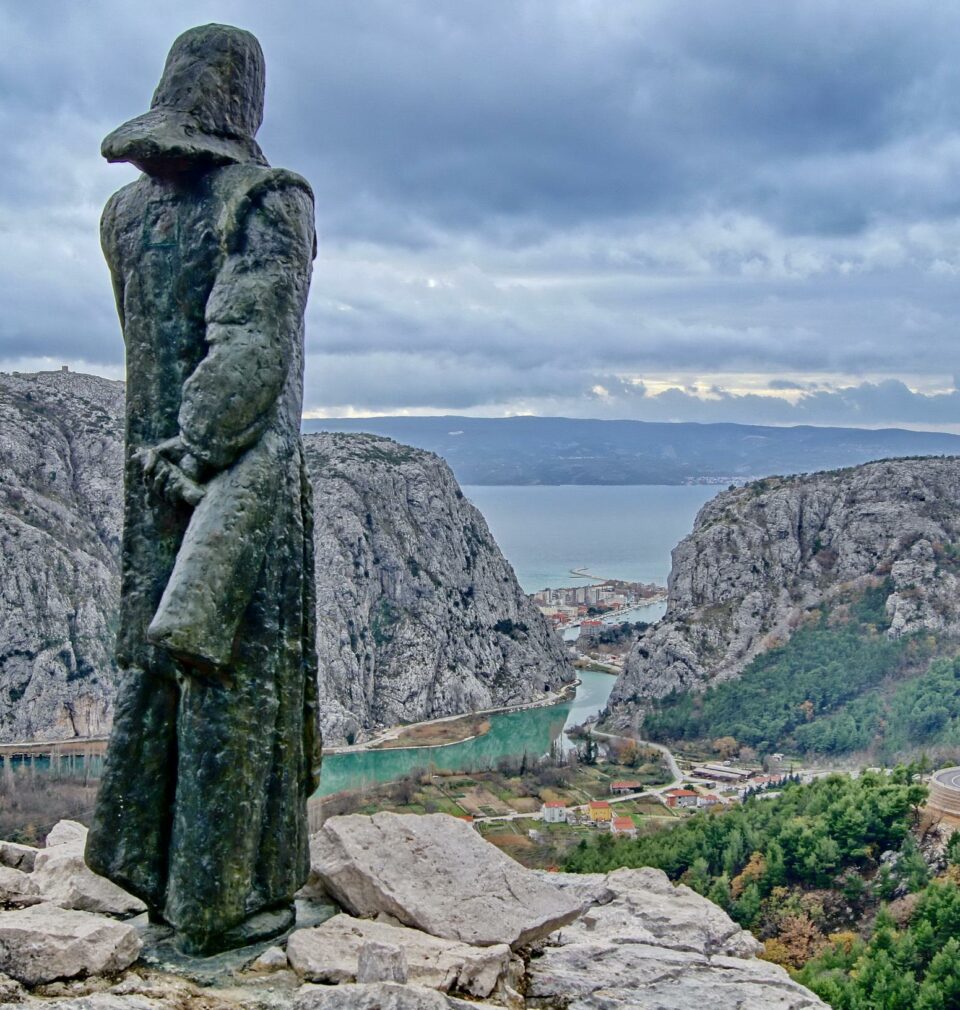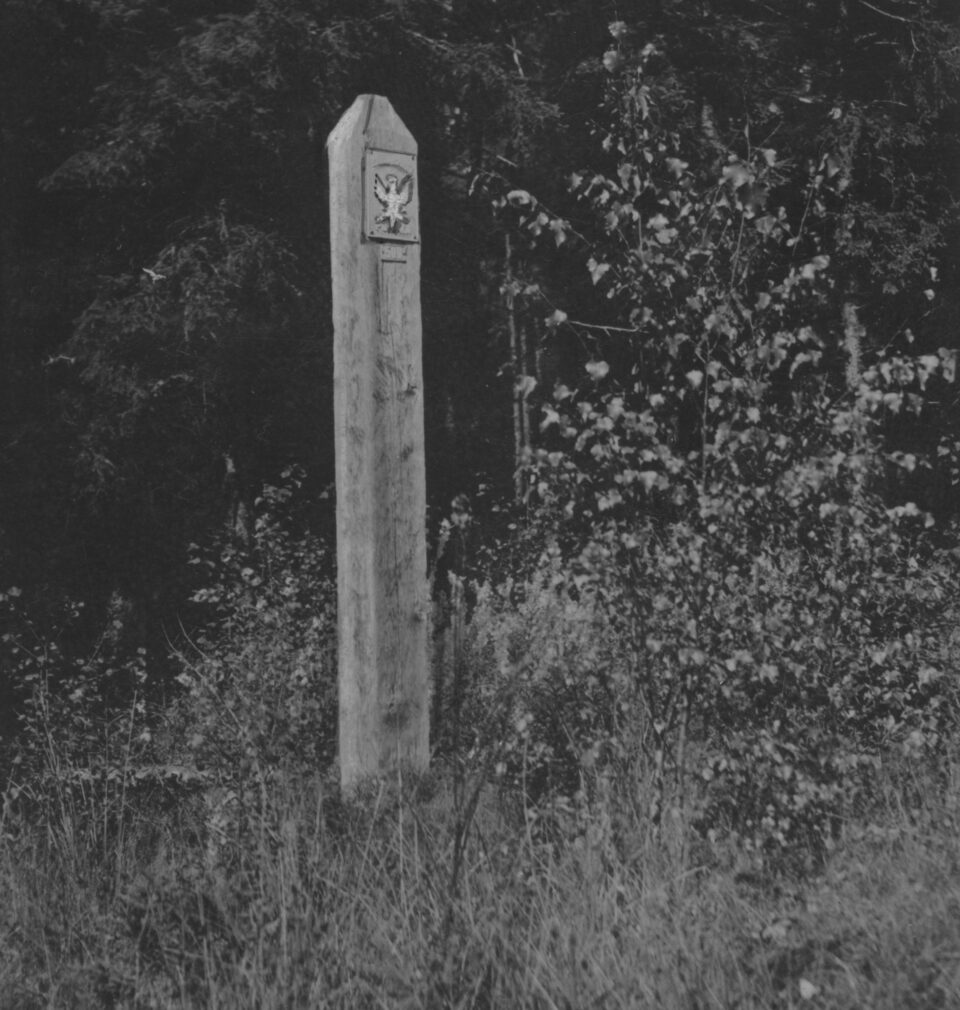
Imagined Identities
A Triestine Triptych (2)
Publication: 17 August 2021
TAGS FOR THE ARTICLE
TO THE LIST OF ARTICLESTo live for almost one hundred years is a privilege. The years 1865-1962 encompassing the life of Max Fabiani define an extraordinary period. The vagaries of his life are governed by two times separated by the turning point of the new century. History does not conform to regular dates, so I am thinking here about the turning point marked by World War I. It closed the long nineteenth century and opened the short, extremely violent twentieth century. Fabiani lived long enough to belong to both centuries and long enough for his biography to fall into a clear “before” and “after”.
Born in Kobdilj (Italian: Cobidil) on the Karst, a limestone plateau above Trieste, he was educated in Ljubljana and then in Vienna. He received an architect’s diploma at the Vienna Technical University. After his schooling there came a time for travelling, rounding up a young man’s education in the tradition of Wanderjahre. Thanks to the Karl Ritter von Ghega Scholarship – named after the constructor of the Semmering mountain line, the crucial railway connection between Vienna and Trieste – Fabiani visited most countries of Europe, from France and Great Britain to Greece and Turkey. Like all Austro-Hungarian beneficiaries of state scholarships, in Rome he lived in the spectacular Palazzo Venezia, regarded by some as Alberti’s work and later housing the Austro-Hungarian Embassy. Joseph Maria Olbrich and Gustav Klimt also stayed there in that period. Their friendship intensified after their return to Vienna and resulted in Fabiani joining the Vienna Secession society created in 1897. It was all the more natural that since 1894 Fabiani worked closely with Otto Wagner, the “father of Modernism” (including the writing of the famous Moderne Architektur). It would seem that these artistic affinities should clearly determine a modern approach of the architect. Yet, in 1896 Fabiani became an assistant to Karl König at the Vienna Technical University and lectured in architectural composition there. König led the retrospective current, turning against the Modernism of Wagner and rediscovering the Baroque, “the first and only style which Austria bestowed on itself” (to quote Albrecht Ilg). In this constellation of contradictions Fabiani was searching for a balance between modern thinking and the tendencies respectful of tradition. The Vienna palaces Portois & Fix (1900) and Artaria (1901) are mentioned in all surveys of Art Nouveau. (The latter heralded in a neighbourly way, so to speak, the famous work of Loos – the Goldman & Salatsch department store, “the milestone” of Modernism, which rose in 1909 just around the corner from Artaria at Michaelerplatz). Buildings are easier to compartmentalise, but in overviews of architectural history we would vainly look for a chapter containing all these works. For it is difficult to define Fabiani exclusively as a revolutionary, given that he moved very adroitly in the Vienna realities. After a brief period of fascination with the new the capital turned its back on Wagner’s vision, relegating him to the largely innocent field of engineering structures. König’s approach was preferred in official architecture, of which Fabiani was well aware and it is probably no accident that designing Urania – a centre of science and education with an astronomical observatory, inaugurated in 1910 by Francis Joseph – he wrapped the daring Raumplan in a classical shell. A historian of architecture writing from the avant-garde perspective may take it against him and he may similarly judge Fabiani’s reputation as a “fashionable” architect, beneficiary of important even if ephemeral commissions of the Imperial Court – various pavilions, exhibitions and settings for celebrations. But, we must take into account the following paradox: while the criteria of Modernism invented in the capital were hard to implement there, in the fast-developing cities in the provinces of the Empire they found very open-minded investors. For two such cities, Ljubljana and the Silesian Bielsko, Fabiani created urban development plans (in 1985 and 1899 respectively), proving to be an excellent town planner. He was sensitive to the cultural value of the cityscape while recognising the need for the city to be functionally laid out. He skilfully avoided the (artificial) opposition between the technocratic urban vision and thinking about the city as a work of art. He was a great practitioner following in the footsteps both of Sitte and of Wagner.
The turning point of the Austro-Hungarian break-up is very important in the biography of Fabiani. In late 1917 he closed his workshop in Vienna and resigned the post of professor of architectural composition. He also rejected the offer of working at the prestigious Charlottenburg Polytechnic Institute and the recently created department of architecture in Ljubljana, which would have undoubtedly allowed him to continue his career. He returned to his native region. What persuaded him to do it was above all the war destruction visited on these areas during the heavy fighting on the Soča (Italian: Isonzo) River. Even before the war had ended, Fabiani campaigned for creating an office responsible for rebuilding the province and he saw himself as overseeing its work. The Austrian authorities complied with his request, but the Gorizia and Gradisca region was soon transferred to another jurisdiction. Fabiani did not interrupt his work. He had predicted that the region would be given to Yugoslavia, but in 1920 it was annexed to Italy. Surprisingly, the new authorities treated him with suspicion. A man feeling at home in three different cultures was a potential trouble-maker in the new times. For the Austrians he was an Italian, for the Yugoslavians he was a German or an Italian, for the Italians he was a Yugoslav supporter and an inveterate Austrian patriot. Although his team prepared almost one hundred projects of renovating cities and villages, he was refused accreditation, his professional competence acquired in Vienna was questioned. Some even doubted if Fabiani, speaking the Trieste dialect, is “truly” Italian. He submitted many designs without signing them, because the officials harassing him could have sidelined them. The necessary compromise with the authorities often meant that Fabiani had to take part in the Italianisation of the region, a project stipulating that when rebuilding Baroque structures (let us recall Albrecht Ilg’s remarks on the Austrian “national” Baroque) their Romanesque or Renaissance form should be “retrieved.” It is obvious that by gaining some trust of the Fascist authorities in Rome, Fabiani could gain acceptance for such huge undertakings as restoring the castles of Gorizia and Štanjel. But one can also imagine forfeiting this chance.
The architect was particularly committed to restoring Štanjel (Italian: San Daniele del Carso), a village of Medieval origin. His native Kobdilj and neighbouring Štanjel practically form one municipality, not only because they share a railway station. The place is located on three hills. Štanjel nestled on the most steep one, the other was taken up by the village of Kobdilj, with wealthy farmsteads, vineyards and the Fabiani estate towering over the village. Between them, on the third hill, is the St. Gregory the Great Cemetery, final resting place for the dead from both Štanjel and Kobdilj. The road between both settlements (a fifteen minutes walk) runs below it. World history has not left its marks here. Instead, the stones of Štanjel speak of the perseverance of a few local families: the Fabianis, the Ferraris, the Stanarjevis, the Kobals or the Ukmars. Fabiani’s return was the return to his own roots and an attempt to inscribe himself into the broader context of the cultural identity of this corner of Europe, where the Alps meet the Adriatic.
When rebuilding and designing houses and homesteads, Fabiani strived to preserve the traditional structures and building techniques, he also renovated local historic monuments. He abandoned his style recognisable in Austria in favour of blending with the vernacular, as a specialist might put it. And an architect / artist was gradually replaced with a landlord. From 1935 to 1945 Fabiani even served as mayor of Štanjel. Almost all of the numerous interwar building projects were based on his designs. But it must be said that his interference in the historic fabric of the village was very restrained.
The hand of the artist is more visible in the house of his brother-in-law, Enrico Ferrari, and the adjoining garden at the foot of the former defensive walls. Planned together with a promenade encircling the town hill, it may be interpreted as an attempt at defining or demarcating one’s place on the earth. At the foot of the Štanjel castle, from the entrance to the promenade, the observer’s look may wander to the afterglow of the sun setting over the Adriatic. There, below the limestone fault, Trieste is to be found. (“Fly me even higher / and I will see the houses of Trieste,” we would like to say, repeating the words of a kite from a poem for children by Oton Župančič). From a small belvedere a few steps further on one can see the bright – especially in the morning – range of the Julian Alps. Successive belvederes offer views on distant and not so distant mountains and the white spots of villages strewn on the hills surrounding the Vipava Valley, that is the Garden of the Empire, as this fertile area was known. And then our gaze returns to the Karst, Carso – severe and good, as wrote Scipio Slataper, Fabiani’s countryman. We can see the closest hill, the one with the cemetery half-way between Štanjel do Kobdilj. In a wall of the cemetery chapel there is a plaque with an inscription regarding a certain Petrus Fabianus, who died in 1633. (The family myth recalls some Friulan ancestors of the Fabianis, who arrived in this area and became loyal subjects of the Gorizian Dukes, and then of the Austrian Emperors). On his mother’s side our architect stemmed from Triestine von Koflers. And he personally designed the tomb of his mother, Charlotta von Kofler Fabiani, standing by a wall of the chapel. Inscriptions on the tomb are in three languages. It is as if everything that he created here was intended to form a story about his family taking root in the Italian-Slovenian-German soil of the Karst. The Fabiani family tomb, also designed by him, was placed next to his mother’s. In 1984 the remains of the architect, who died in Gorizia twenty two years earlier, were laid to rest in it.
The route ends with the Medieval Kobdilj Gate, but passing the church square and the castle, one can re-enter the promenade and repeat this wandering, in the same cycle of birth and death which for centuries has given rhythm to the life of generations persisting on this stony outcrop of the Karst.
In Štanjel Max Fabiani created his own territory which in itself is a work of art. One can see in it an embodiment of the Romantic idea of “total work,” but also a kind of Modernist Gesamtkunstwerk, splicing together space and time and inscribing in them particular values and a way of life. This is as much as a historian of architecture can say. But I think that Fabiani’s work demands a different kind of attention; not the one employed by rigorous scholarship, to repeat after Czesław Miłosz. For a work offers itself as a fate fulfilled, although fulfilled not through artistry with the biography somewhere in the background, but as a unity of producer and the thing produced; a kind of autobiography, but based on different rules. What rules? This is the whole secret.
The inveterate Austrian patriotism of Fabiani is reminiscent of Hugo von Hofmannsthal’s attachment to the “Austrian idea.” Could Fabiani’s decision to “exit stage” and leave Vienna have been accompanied by the feeling expressed by Hofmannsthal with the following words: “My country survived, but my only homeland now is Europe?”[1] What is the source of Fabiani’s fervent desire to build, but in a different way than before, that is not only to build, but also to merge, become one with the place? Was it an instinctive response against break-up and against the unpredictable?
Max Fabiani experienced the arbitrariness of frontiers, he was aware that they could blindly cut through what was formerly one whole, and he saw how new residents were brought by official decree to places on Soča made desolate by the war. The duality of feelings: familiarity and strangeness brings to mind the remarks of Sándor Márai put down in his diary. “The process of decomposition is always logical,” he wrote in 1945, summing up the reasons for his leaving Hungary. “In the preceding years I lost my work and my home, the social class for which I had been writing vanished, then I lost my homeland, my native language, my legal personality. Now I have nothing.”[2] In order to survive, Márai had to create some semblance of a framework of existence. For this purpose he used the Hungarian language cultivated in a foreign land and a dream of Europe cultivated no less scrupulousness. But he was aware that Europe was for him not only an idea, a tradition or a unique spiritual pattern, but also places, walls, images. Hence the dramatic diary entries from the war period about bombed cities. “The news about bombing Rome shook me more than anything I had heard and experienced during this war […],” he wrote in 1943. “In those days I realised that Rome was one of the most important private matters of humanity.” And slightly further on: “The English took Palermo. […] An incredible city, a capital of legends. Now it shares the fate of Warsaw.”[3]
“A capital of legends” – it seems that these words succinctly express the belief that cities form the fabric of memory necessary for the continent, and thus they must be protected at all costs. Citing Márai, I wonder about the thoughts of Fabiani when he was working indefatigably on recreating the cultural landscape of his native area. For him the most important “private matter of humanity” was the painstakingly renovated castle in Štanjel. When Márai was worrying about the fate of Rome, Palermo, Warsaw and many other European cities, Fabiani, mayor of Štanjel, tried to save the village from destruction. After the Italian capitulation in 1943 the region was captured by the Germans. Few men remained in the village and in the nearby Kobdilj – most of them joined Tito’s Partisans. Destroying both places was to be the German’s revenge. Mayor Fabiani negotiated with the German commander. He invoked his personal acquaintance with the Führer.
And indeed, in 1912 a young man named Hitler appeared in his workshop. He wanted to study architecture under Wagner, but he was turned down by the Academy. He tried his luck with Fabiani, practically the second architect of the Monarchy. Fabiani gave him a chance and accepted him as a draftsman. He is even supposed to have said about Hitler that “he will come to something.” Adolf Hitler did not stay long, after three months their ways parted, but he did learn something in the architect’s workshop. He was undoubtedly interested in architecture, even then he was entertaining some ideas for Berlin.
The German commander hesitated, unable to confirm the mayor’s words. Unfortunately, the negotiations came to nothing, for in September 1944 Kobdilj and Štanjel were destroyed in the fighting with the Partisans. For three years this part of the Karst was within one of the zones of the Free Territory of Trieste – a provisional creation under international supervision. Fabiani did not wait for final decisions but started the reconstruction effort. Very much was done but many scars will never fade. In 1947 these areas were given to Yugoslavia and Max Fabiani moved to Gorizia. Despite so many personal ties with the Slovenians, it was easier for the post-war Yugoslav authorities to see in Fabiani an Italian traitor rather than the creator of the Trieste National House and the designer of modern Ljubljana. The holiness of the national independence struggle was not to be disputed. In the early 1950s Edvard Kocbek had the daring to write that truth in human life and in history is never clear-cut and final, that we can never see both sides of it, for when one is visible, the other remains hidden, but no one in Slovenia supported him. Only Boris Pahor, a Slovenian writer living in Trieste, backed his position[4]. (The voice of “a man from the margins,” someone looking also from the other side, this voice of the twentieth century Slovenian literature heard already in Cankar and Kocbek, and upheld by Pahor and Jančar, will remain an underground river for a long time to come.)
Sometimes things unexpectedly complete a full circle. When Max Fabiani visited Bielsko fifty years earlier, it became obvious for him that there was no other way for this Silesian town than merging with the Galician Biała. And in his urban development plan he predicted that in the future these two dynamic industrial centres would absorb the border-line dividing them. Later Fabiani himself had to make the effort of internalising the border-line, inventing some way of standing astride it. But as an old man he experienced the atavistic force of borders when he moved to Gorizia, a few steps from the railway station square dissected by no less a border than the Iron Curtain. Štanjel remained on the other side, when the Corbusieresque Nova Gorica soon came into being.
Not all was gold, as Marco Pozzetto, Fabiani’s monographer and a devoted guardian of his legacy, honestly admitted. In the new times it was extremely difficult to emancipate oneself from the historical circumstances, to resist the daily pressure of events or even to keep vigilant. Fabiani did not become a recluse, because architecture is like a letter – it has its recipients. His attempt to escape history, to make a retreat, is like moving from the avant-garde to “derrière-garde,” in order to defend the real content and value of what one has produced. His fate was part of a larger wave of a kind of withdrawal in Europe, attentively followed by Jerzy Stempowski. “The Italian language retreated to the Western Adriatic shore,” wrote the essayist, “just as the German retreated across the Oder and the Polish retreated across the Bug and the San. And the French, once a language known to all educated people, became understandable only to students of French studies.”[5]
“Today most of the Western philosophy proclaims the praise of the end of values and the collapse of the term veritas,” I read in the essay Europe as Seen from Trieste by Claudio Magris. But a few lines further on the writer formulates a message which could help in finding the way. An artist “suspicious of revolutions and noisy rebellions must remember about the centuries which are behind him, about the wisdom and scepticism taught by them […], for the sense of the profound […] discredits the tribal idols, ready to pronounce themselves gods. With such a legacy of authentic humanitas or rather with an adequate vision of the relation between time and eternity, it will be possible to preserve the glow of the little flame, to send a letter in a bottle, to resist the wooing of power in a quiet and dignified way, even when the wooing is honest and institutions democratic.”[6] A fate fulfilled proves to be a letter extracted from a bottle, although not all was gold.
I would like to thank Vesna and Marijan Černe for showing me the native land of Max Fabiani
Further acknowledgements
Adijo Dunaj, pozdravljen Štanjel. Razstava o arhitektu Maksu Fabianiju, o njegovem kraju in njegovih ljudeh, exhibition catalogue, Galerija Lojžeta Spacala v Štanjelu 2004, Arhitekturni muzej Ljubljana 2005.
Maks Fabiani, Akma. Duša sveta, Štanjel 1999.
Renato Ferrari, Murva Fabianijevih. Stoletje miru na Krasu, Trst 2001.
Andrej Hrausky, Janez Koželj, Maks Fabiani. Dunaj, Ljubljana, Trst, Ljubljana 2010.
Marko Pozzetto, Maks Fabiani – vizije prostora, Kranj 1997.
Ursula Prokop, O różnorodności i jednoczesności. Spojrzenie na architekturę Wiednia około roku 1900, in Otto Wagner. Wiedeń, architektura, około 1900, Jacek Purchla (ed.), Krakow 2000.
***
[1] “Meine Heimat habe ich behalten, aber Vaterland habe ich keines mehr, als Europa”, quoted in Hugo von Hofmannsthal, Carl J. Burckhardt, Briefwechsel, hrsg. Carl J. Burckhardt, Frankfurt am Main 1956, p. 210.
[2] Sándor Márai, Dziennik (fragmenty), translated by Teresa Worowska, Warszawa 2007, p. 152.
[3] Ibidem, pp. 19-20.
[4] Joanna Pomorska, “Casus Kocbek,” Literatura na Świecie 1986, No. 1 (174), pp. 16–18.
[5] Jerzy Stempowski, Słońce jesieni, in idem, Od Berdyczowa do Lafitów, selected by Andrzej Stanisław Kowalczyk, Wołowiec 2001, p. 483.
[6] Claudio Magris, “Europa widziana z Triestu”, translated by Joanna Ugniewska, Zeszyty Literackie 2005, No. 90, p. 33.
Copyright © Herito 2020



